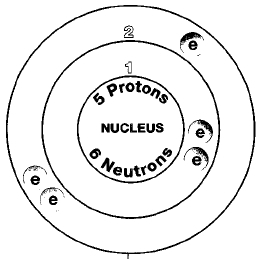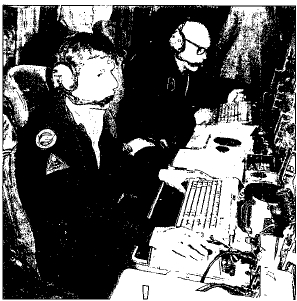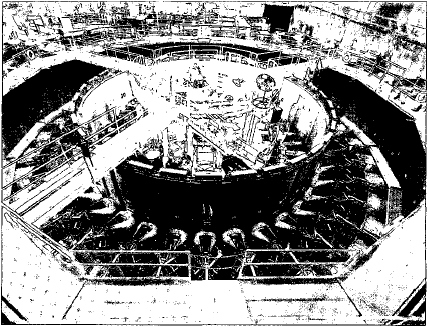Go to the main page

Boron is quite different from other members of the family. One difference is that boron is not a metal. All other members of the family (aluminum, gallium, indium, and thallium) are metals.
Compounds of boron have been used for centuries. Borax, a boron compound, has long been used to make glass and glazes. The element itself was not identified until 1808.
The most important use of boron is still in glass manufacture. Agriculture, fire retardants, and soaps and detergents rely on boron compounds.
Borax was widely used by crafts people. It reduces the melting point of materials used to make glass. It was also used to melt the ores of metals and to isolate the metals from those ores.
In 1808, English chemist Humphry Davy (1778-1829) had just learned how to isolate the most active metals, such as sodium and potassium. He was also working on a method to remove boron from its compounds. (See sidebar on Davy in the calcium entry.)
Ads by Google
Financial Engineering
University of Hawaii's Intensive
1-year Master Program
mfe.shidler.hawaii.edu
Executive MBA NIIT-IGNOU
18 Months Executive Program for
Professionals with 3+ Years of Exp.
www.program.niitimperia.com
Distance MBA
Earn Dual Degree PGDBA + MBA Online
From ADTU & MITSDE. Contact Today!
www.mitsde.com
Study Abroad Free Session
Special Workshop on Study Abroad &
Overseas Admission Process. Signup!
ManyaGroup.com/Study-Abroad-Session
News of Davy's success had traveled to France, where emperor Napoleon Bonaparte (1769-1821) grew concerned about the scientific reputation of his country. He ordered larger and better equipment built for his scientists. He wanted them to surpass Davy in his work on metals. This equipment was designed especially for two French chemists, Louis Jacques Thênard (1777-1857) and Joseph Louis Gay-Lussac (1778-1850).
Thênard and Gay-Lussac found a new way to separate boron from its compounds. They heated boracic acid (also known as boric acid, H 3 BO 3 ) with potassium metal to produce impure boron. Thênard and Gay-Lussac were given credit for discovering the new element. In 1892, French chemist Henri Moissan (1852-1907) produced boron that was 98 percent pure.
The names borax and boracic acid probably originated as far back as the time of Rhazes as buraq (in Arabic) or burah (in Persian).
All forms of boron have very high melting points, from 2,200 to 2,300°C (4,000 to 4,200°F).
One property of special importance is boron's ability to absorb neutrons. Neutrons are subatomic particles with no charge that occur in the nucleus of nearly all atoms. Boron atoms are able to absorb a large number of neutrons. This makes boron useful in the control rods of nuclear reactors.
A nuclear reactor is a device for generating energy from nuclear fission reactions. Nuclear fission is the process in which large atoms are split, releasing large amounts of energy and smaller atoms. In a nuclear reactor, it is essential that just the right number of neutrons are present. Too many neutrons can cause a fission reaction to get out of control. Too few neutrons and a fission reaction stops.
Control rods are long tubes packed with boron (or some other element). The rods can be raised and lowered in the reactor. As the rods are lowered into the core, the boron absorbs neutrons, slowing the reaction.
Boron is not soluble in water. It normally does not react with acids. In powder form, it reacts with hot nitric acid (HNO 3 ) and hot sulfuric acid (H 2 SO 4 ). It also dissolves in molten (melted) metals.
Boron never occurs as a free element but always as a compound. The most common minerals of boron are borax, or sodium borate (Na 2 B 4 O 7 ); kernite (another form of sodium borate); colemanite, or calcium borate (Ca 2 B 6 O 11 ); and ulexite, or sodium calcium borate (NaCaB 5 O9 ). These minerals usually occur as white crystalline deposits in desert areas. The two largest world producers of boron compounds are Turkey and the United States. Smaller amounts come from Argentina and China. Nearly all of the boron in the United States comes from three California counties: Kern, San Bernadino, and Inyo.
R adiation can kill living cells. Light, X rays, radio waves, and microwaves are all forms of radiant energy. These forms of radiation differ from each other in the amount of energy they carry with them. X rays carry a great deal of energy; light waves, less energy; and radio waves, very little energy.
The bad news about high-energy radiation is that it can kill healthy cells. A person exposed to high levels of X rays will become ill and may die. Because the X rays kill so many cells, the person's body cannot survive. Essential body functions stop, and death occurs.
The good news is that high-energy radiation can be used to kill cancer cells. Cancer cells are abnormal cells that reproduce faster than normal tissue. The rapidly dividing cells form tumors, crowd organs, and shut down some organ function. Radiation is one way to kill cancer cells.
The problem lies in killing only the cancer cells. The radiation has to be "targeted" at the cancer (bad) cells, and not the healthy (good) cells. Scientists think that using boron may be one way of achieving this goal. A new procedure called boron neutron capture therapy (BNCT) is one method for targeting cancer cells.
With BNCT, a person with cancer receives an injection of boron. The boron tends to go directly to cancer cells. The patient receives an injection of boron that deposits only in the cancer cells. Scientists currently do not know why boron favors cancer cells. But it does.
The patient's body is then bombarded with neutrons that pass through without harming health cells. They then collide with boron atoms. This causes boron to be converted into lithium atoms, alpha particles, and gamma rays. An alpha particle is a helium atom without electrons. Gamma radiation is very high-energy radiation that can kill cells.
The lithium atoms and alpha particles travel only a short distance. They do not leave the cancer cell but have enough energy to kill the cell. Since they do not leave the cell, they pose no threat to healthy cells nearby.
BNCT is not fully developed. But it holds great promise as a cancer treatment.

Overview
Boron is the first element in Group 13 (IIIA) of the periodic table. The periodic table is a chart that shows how the chemical elements are related to each other. The elements in this group are usually referred to as the aluminum family.Boron is quite different from other members of the family. One difference is that boron is not a metal. All other members of the family (aluminum, gallium, indium, and thallium) are metals.
Compounds of boron have been used for centuries. Borax, a boron compound, has long been used to make glass and glazes. The element itself was not identified until 1808.
The most important use of boron is still in glass manufacture. Agriculture, fire retardants, and soaps and detergents rely on boron compounds.
SYMBOL
B
ATOMIC NUMBER
5
ATOMIC MASS
10.811
FAMILY
Group 13 (IIIA)
PRONUNCIATION
BOR-on
B
ATOMIC NUMBER
5
ATOMIC MASS
10.811
FAMILY
Group 13 (IIIA)
PRONUNCIATION
BOR-on
Discovery and naming
The first mention of boron compounds is found in a book by Persian alchemist Rhazes (c. 865-c. 925). Alchemists studied the nature of matter before modern chemistry was born. Rhazes classified minerals into six classes, one of which was the boraces, which included borax.Borax was widely used by crafts people. It reduces the melting point of materials used to make glass. It was also used to melt the ores of metals and to isolate the metals from those ores.
In 1808, English chemist Humphry Davy (1778-1829) had just learned how to isolate the most active metals, such as sodium and potassium. He was also working on a method to remove boron from its compounds. (See sidebar on Davy in the calcium entry.)
Ads by Google
Financial Engineering
University of Hawaii's Intensive
1-year Master Program
mfe.shidler.hawaii.edu
Executive MBA NIIT-IGNOU
18 Months Executive Program for
Professionals with 3+ Years of Exp.
www.program.niitimperia.com
Distance MBA
Earn Dual Degree PGDBA + MBA Online
From ADTU & MITSDE. Contact Today!
www.mitsde.com
Study Abroad Free Session
Special Workshop on Study Abroad &
Overseas Admission Process. Signup!
ManyaGroup.com/Study-Abroad-Session
Thênard and Gay-Lussac found a new way to separate boron from its compounds. They heated boracic acid (also known as boric acid, H 3 BO 3 ) with potassium metal to produce impure boron. Thênard and Gay-Lussac were given credit for discovering the new element. In 1892, French chemist Henri Moissan (1852-1907) produced boron that was 98 percent pure.
The names borax and boracic acid probably originated as far back as the time of Rhazes as buraq (in Arabic) or burah (in Persian).
Physical properties
One of the unusual properties of boron is the many physical forms, called allotropes, in which it occurs. Allotropes are forms of an element with different physical and chemical properties. One form of boron consists of clear red crystals with a density of 2.46 grams per cubic centimeter. A second form consists of black crystals with a metallic appearance and a density of 2.31 grams per cubic centimeter. Boron can also occur as a brown powder with no crystalline structure. The density of this powder is 2.350 grams per cubic centimeter.All forms of boron have very high melting points, from 2,200 to 2,300°C (4,000 to 4,200°F).
One property of special importance is boron's ability to absorb neutrons. Neutrons are subatomic particles with no charge that occur in the nucleus of nearly all atoms. Boron atoms are able to absorb a large number of neutrons. This makes boron useful in the control rods of nuclear reactors.
A nuclear reactor is a device for generating energy from nuclear fission reactions. Nuclear fission is the process in which large atoms are split, releasing large amounts of energy and smaller atoms. In a nuclear reactor, it is essential that just the right number of neutrons are present. Too many neutrons can cause a fission reaction to get out of control. Too few neutrons and a fission reaction stops.
Control rods are long tubes packed with boron (or some other element). The rods can be raised and lowered in the reactor. As the rods are lowered into the core, the boron absorbs neutrons, slowing the reaction.
Chemical properties
Boron combines with oxygen in the air to form boron trioxide ( B 2 O 3 ). Boron trioxide forms a thin film on the surface that prevents further reaction with oxygen.Boron is not soluble in water. It normally does not react with acids. In powder form, it reacts with hot nitric acid (HNO 3 ) and hot sulfuric acid (H 2 SO 4 ). It also dissolves in molten (melted) metals.
Occurrence in nature
The abundance of boron in the Earth's crust is estimated to be about 10 parts per million. That places it in about the middle among the elements in terms of their abundance in the earth.Boron never occurs as a free element but always as a compound. The most common minerals of boron are borax, or sodium borate (Na 2 B 4 O 7 ); kernite (another form of sodium borate); colemanite, or calcium borate (Ca 2 B 6 O 11 ); and ulexite, or sodium calcium borate (NaCaB 5 O9 ). These minerals usually occur as white crystalline deposits in desert areas. The two largest world producers of boron compounds are Turkey and the United States. Smaller amounts come from Argentina and China. Nearly all of the boron in the United States comes from three California counties: Kern, San Bernadino, and Inyo.
The good and bad of radiation
The bad news about high-energy radiation is that it can kill healthy cells. A person exposed to high levels of X rays will become ill and may die. Because the X rays kill so many cells, the person's body cannot survive. Essential body functions stop, and death occurs.
The good news is that high-energy radiation can be used to kill cancer cells. Cancer cells are abnormal cells that reproduce faster than normal tissue. The rapidly dividing cells form tumors, crowd organs, and shut down some organ function. Radiation is one way to kill cancer cells.
The problem lies in killing only the cancer cells. The radiation has to be "targeted" at the cancer (bad) cells, and not the healthy (good) cells. Scientists think that using boron may be one way of achieving this goal. A new procedure called boron neutron capture therapy (BNCT) is one method for targeting cancer cells.
With BNCT, a person with cancer receives an injection of boron. The boron tends to go directly to cancer cells. The patient receives an injection of boron that deposits only in the cancer cells. Scientists currently do not know why boron favors cancer cells. But it does.
The patient's body is then bombarded with neutrons that pass through without harming health cells. They then collide with boron atoms. This causes boron to be converted into lithium atoms, alpha particles, and gamma rays. An alpha particle is a helium atom without electrons. Gamma radiation is very high-energy radiation that can kill cells.
The lithium atoms and alpha particles travel only a short distance. They do not leave the cancer cell but have enough energy to kill the cell. Since they do not leave the cell, they pose no threat to healthy cells nearby.
BNCT is not fully developed. But it holds great promise as a cancer treatment.
Isotopes
Two naturally occurring isotopes of boron exist: boron-10 and boron-11. Isotopes are two or more forms of an element. Isotopes differ from each other according to their mass number. The number written to the right of the element's name is the mass number. The mass number represents the number of protons plus neutrons in the nucleus of an atom of the element. The number of protons determines the element, but the number of neutrons
Boron alloys are used in magnets in microphones and headphones.
Three radioactive isotopes of boron are known also. A radioactive isotope is one that breaks apart and gives off some form of radiation. Radioactive isotopes are produced when very small particles are fired at atoms. These particles stick in the atoms and make them radioactive.
None of the radioactive isotopes of boron have any important commercial uses.
Extraction
Boron is still produced by a method similar to that used by Thênard and Gay-Lussac. Boric oxide is heated with powdered magnesium or aluminum:
Particle accelerators include magnets that consist of boron alloys.
The element can also be obtained by passing an electric current through molten (melted) boron trichloride:
Uses
Boron is used to make certain types of alloys. An alloy is made by melting and mixing two or more metals. The mixture has properties different from those of the individual metals. The most important of these alloys commercially are used to make some of the strongest magnets known. The rare earth magnets, for example, are made from boron, iron , and neodymium. These magnets are used for microphones, magnetic switches, loudspeakers, headphones, particle accelerators, and many technical applications.The use of boron in nuclear power plants was described above under "Physical properties."
Compounds
Glass fiber insulation is also made from borosilicate glass by forcing it through narrow openings. The glass comes out as a thin fiber and is then spun into insulation. These fibers trap air. Since neither the borosilicate fibers nor air is a good conductor of heat, it makes excellent insulation. Much of the insulation used in private homes, office buildings, and other structures is made of borosilicate fibers.
Fibers made from borosilicate glass are also used in making cloth. Borosilicate fibers are blended with other synthetic fibers to make durable fabric for automobile seat covers and other long-wear applications.
Boron also forms important compounds with two other elements, carbon and nitrogen. Boron carbide (B 4 C) and boron nitride (BN) are important compounds because of their hardness. In fact, boron nitride may be the hardest substance known. Both compounds have very high melting points: 2,350°C (4,300°F) for boron carbide and more than 3,000°C (5,400°F) for boron nitride.
These properties make boron carbide and boron nitride useful as abrasives and refractories. An abrasive is a powdery material used to grind or polish other materials. A refractory material is one that can withstand very high temperatures by reflecting heat. Refractory materials line ovens to maintain high temperatures.
Studies suggest that a lack of boron may lead to arthritis and other disorders of the skeleton.
Boron carbide and boron nitride are used in high-speed tools, military aircraft and spacecraft, heat shields, and specialized heat-resistant fibers. They also are found in face powders, cream make-ups, and lipsticks.Small amounts of boron compounds are also used to control the growth of weeds in agriculture, and as insecticides, fertilizers, and flame retardants. A flame retardant is a material that prevents another material from catching fire and burning with an open flame.
No comments:
Post a Comment